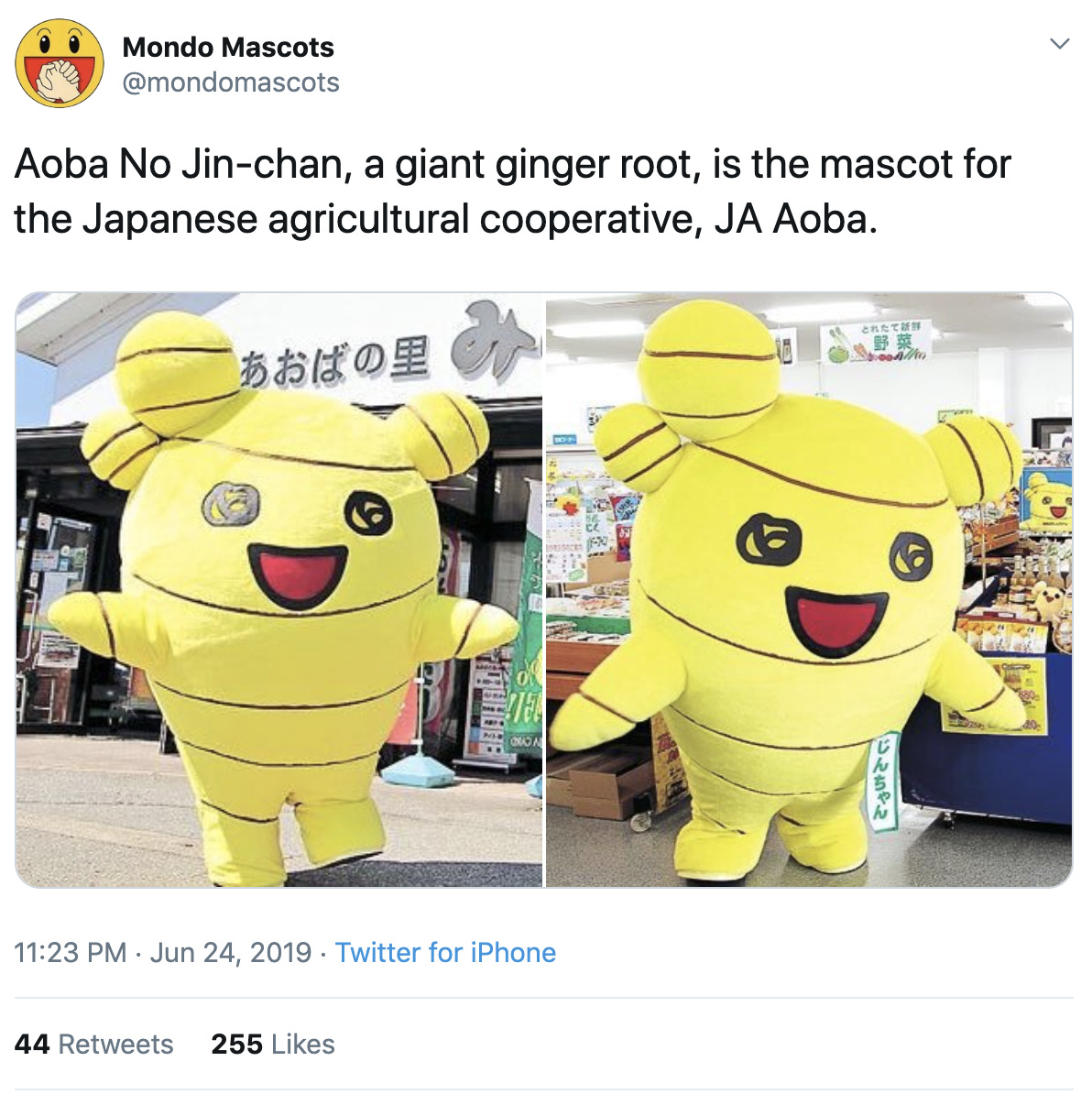Keith O’Brien (KOB) works in marketing and content strategy and is about to start doing both for a biotech startup. He also worked with Colin in his previous life. He writes about an assortment of stuff at keithrobrien.com and, naturally, his newsletter God Damn Honey. - Noah (NRB)
Keith here. One of my favorite follows on Twitter is @MondoMascots (website here). The single-use Twitter focuses on the interesting and unique world of Japanese mascots. The mascots are often times either an anthropomorphic representation of a corporation’s product, a prefecture or city’s more prevalent feature, or an animal with odd items on its head. Many invoke puns, some are just hard to believe they exist, and others are … ginger?

Mondo Mascots’ creator Chris Carlier has lived in Japan for over 16 years. He spoke in depth to Vice at the beginning of the year about what led him to chronicle the phenomenon. These mascots, also known as Yuru-chara, are a huge business. The last widely published figure put attendant merchandise sold in 2012 at $12 billion. Every prefecture has at least one official mascot. Most businesses have one too, and even the transport pass company, Suica, has a mischievous penguin. They’ve been around for a while, but Yuru-chara watchers claim the flashpoint for the most recent obsession was the unveiling of Hikonyan in 2007 for Hikone Castle’s 400th anniversary. It brought people far and wide and led more organizations and locations to up their Yuru-chara game.
Why is this interesting?
Japanese mascots are especially having their moment in the sun thanks to Chiitan, the trolling and aggressive mascot you may have seen on John Oliver’s Last Week Tonight.

As the New York Times’ definitive report puts it, the Japanese city of Susaki made a living otter an honorary tourism ambassador. Soon after, design company Charando created an otter mascot Chiitan, which began showing up around the city performing dangerous and annoying stunts, drawing attention away from the official Susaki otter-based mascot Shinjokun. Twitter suspended Chiitan for yet-unexplained reasons. It’s likely not the content that was the issue, because this “unofficial account” has been around for a while.
Some Yuru-chara, like Chiitan are unsanctioned, which creates a tense alliance with the regions or organizations they purport to represent. Susaki embraced Chiitan until it didn’t on account of the trouble it caused. So on any given day, on any street in Japan, you could run into a mix of mascots ambling about. Some are official, some, like Chiitan, are professionally made and looking to cause mischief, and others are poorly designed, created by an individual who decided he or she wanted to be a mascot. Carlier, for his part, is now trying to create his own mascots, potentially one representing the “immigrant community to Japan.” (KOB)
Photo of the Day:
The infamous Suica Penguin. (CJN)

Quick Links:
Japan’s department of tourism provides deeper intel on the mascots, identifying their sexes and birthdates (KOB)
Lost to the ages is a Tumblr that collected instances of animal mascots eating themselves (especially popular in BBQ signage — this is another chronicler of that trend http://suicidefood.blogspot.com/) (KOB)
Deadspin’s Women’s World Cup VAR coverage has been excellent. This one demonstrates just how many penalty kick saves in history would have been overturned today (KOB)
A few other favorite single-use Twitter accounts: @NightOpening for 90s movie premiere night fashion, @wiki-tmnt for Wikipedia titles you can sing to the theme of Teenage Mutant Ninja Turtles, @UlyssesReader for the entirety of James Joyce’s Ulysses tweeted +/-280 characters at a time. (KOB)
Thanks for reading,
Noah (NRB) & Colin (CJN) & Keith (KOB)


